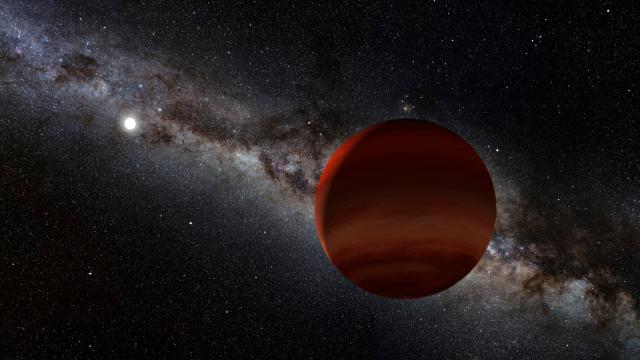Astronomers recently spotted one of the most massive brown dwarfs known, an object between 75 and 90 times the mass of Jupiter with a beyond-scalding dayside temperature of 8,000 K (13,940° Fahrenheit.)
For comparison, the Sun’s surface is a mere 5,772 K (9,930° Fahrenheit). Astronomers observed the piping-hot, supersized brown dwarf in 2019 and 2020 using the European Southern Observatory’s Very Large Telescope. Their findings were published today in Nature Astronomy.
Brown dwarfs sit at the awkward in-between that separates planets from stars. The objects are larger than gas giants like Jupiter, but teenier than small stars. Because brown dwarfs fall short of the masses necessary for stars to burn hydrogen for their nuclear fusion, the objects are sometimes called failed stars.
The recent research team took a more respectful approach, calling the object (WD 0032-317B) an “irradiated-Jupiter analogue.” The dwarf orbits a white dwarf star that sits 1,406 light-years from Earth. The astronomical team posits that the brown dwarf was in a gas envelope with its partner white dwarf until about one million years ago.
Its high temperature is something to appreciate because brown dwarfs are generally the coolest, dimmest objects on the Hertzsprung-Russell diagram that maps stars’ luminosities and effective temperatures.
The dwarf is tidally locked, meaning that its scalding dayside always faces the white dwarf, which has a surface temperature of about 37,000 K (66,140° Fahrenheit). The brown dwarf’s nightside temperature is much cooler than its star-facing side, hovering around 2,000 K (1,727° Fahrenheit.)
Comparing brown dwarfs to hot Jupiters—gas giant exoplanets that orbit their host stars closely, making them piping hot—is not new. It was proven more apt than previously realised in 2021, when astronomers found evidence of stripes and polar storms like those seen on Jupiter on brown dwarfs. But the dwarfs can also be cooler than the boiling point of water; the coldest-known brown dwarf has a frigid temperature of -10° Fahrenheit, indicating to some that it’s not a brown dwarf at all, but a rogue exoplanet.
Spotting more brown dwarfs may clarify the diversity and nature of these hot, massive objects. A new paper hosted on the preprint server arXiv describes a brown dwarf with an astoundingly quick orbit of just two hours. The dwarf was spotted by the Zwicky Transient Facility and has a mass 80 times that of Jupiter, with an effective temperature of about 1,691 K (2,584° Fahrenheit)—quite cool compared to WD 0032-317B.
Last week, a different team of astronomers published a captivating GIF of an exoplanet’s orbit. The exoplanet could be imaged because it was “at the boundary of a planet and a brown dwarf,” according to study author and Northwestern astronomer Jason Wang.
Perhaps astronomers will apply the same technique to brown dwarfs in the future, to better understand the systems the dwarfs occupy. Or, astronomers could train the Webb Space Telescope’s perceptive gaze on these irradiated-Jupiter analogues, as they’ve done before with fainter, more distant, colder dwarfs than WD 0032-317B.
